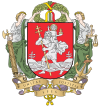Vilniaus
| Vilnius | |||
|---|---|---|---|
| City | |||

Clockwise from top right: Gediminas' Tower, Vilnius business district, Presidential Palace, Pilies Street, Gate of Dawn, St. Anne's Church.
|
|||
|
|||
| Nickname(s): Jerusalem of Lithuania, Rome of the North, Athens of the North, New Babylon, The city/capital of Palemon | |||
| Motto: Unitas, Justitia, Spes (Latin: Unity, Justice, Hope) |
|||
 Location of Vilnius |
|||
| Coordinates: 54°41′N 25°17′E / 54.683°N 25.283°ECoordinates: 54°41′N 25°17′E / 54.683°N 25.283°E | |||
| Country |
|
||
| Ethnographic region | Dainava | ||
| County | Vilnius County | ||
| Municipality | Vilnius City Municipality | ||
| Capital of | Lithuania | ||
| First mentioned | 1323 | ||
| Granted city rights | 1387 | ||
| Elderships | |||
| Government | |||
| • Type | City council | ||
| • Mayor | Remigijus Šimašius | ||
| Area | |||
| • City | 401 km2 (155 sq mi) | ||
| • Metro | 9,731 km2 (3,757 sq mi) | ||
| Elevation | 112 m (367 ft) | ||
| Population (2015) | |||
| • City | 542,664 | ||
| • Rank | (52nd in EU) | ||
| • Density | 1,392/km2 (3,610/sq mi) | ||
| • Urban | 692,528 | ||
| • Metro | 805,142 | ||
| • Metro density | 83/km2 (210/sq mi) | ||
| Demonym(s) | Vilnian | ||
| Time zone | EET (UTC+2) | ||
| • Summer (DST) | EEST (UTC+3) | ||
| Postal code | 01001-14191 | ||
| Area code(s) | (+370) 5 | ||
| GDP (nominal) Vilnius county |
2015 | ||
| - Total | €15.1 billion/ USD 17 billion | ||
| - Per capita | €18,700/ USD 21,000 | ||
| Website | www |
||
Vilnius (Lithuanian pronunciation: [ˈvʲɪlʲnʲʊs], see also other names) is the capital of Lithuania and its largest city, with a population of 542,664 as of 2015[update]. Vilnius is located in the southeast part of Lithuania and is the second largest city in the Baltic states. Vilnius is the seat of the main government institutions of Lithuania as well as of the Vilnius District Municipality. Vilnius is classified as a Gamma global city according to GaWC studies, and is known for the architecture in its Old Town, declared a UNESCO World Heritage Site in 1994. Prior to World War II, Vilnius was one of the largest Jewish centers in Europe. Its Jewish influence has led to it being described as the "Jerusalem of Lithuania" and Napoleon named it "the Jerusalem of the North" as he was passing through in 1812. In 2009, Vilnius was the European Capital of Culture, together with the Austrian city of Linz.
The name of the city originates from the Vilnia River. The city has also been known by many derivate spellings in various languages throughout its history: Vilna was common in English. The most notable non-Lithuanian names for the city include: Polish: Wilno, Belarusian: Вiльня, German: Wilna, Latvian: Viļņa, Russian: Вильнюс, Yiddish: ווילנע (Vilne), Czech: Vilnius. A Russian name from the time of the Russian Empire was Вильна/Вильно (Vilna/Vilno), although Вильнюс (Vilnius) is now used. The names Wilno, Wilna and Vilna have also been used in older English, German, French and Italian language publications when the city was one of the capitals of Polish–Lithuanian Commonwealth and later of Second Polish Republic. The name Vilna is still used in Finnish, Portuguese, Spanish, and Hebrew. Wilna is still used in German, along with Vilnius.
...
Wikipedia


